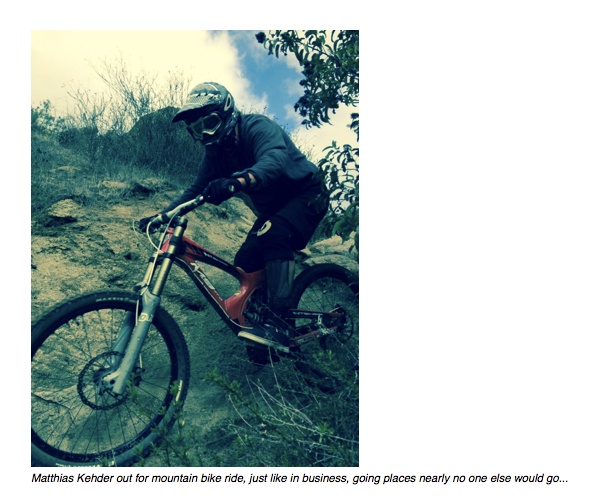A Q&A with Matthias Kehder CEO and Co-founder of Modern Analytics
Q: Thanks for taking some time to inform me, and other data analytics-minded professionals, about one of the most exciting technologies on the market. To start out, please share a little about your background in the realm of data analytics and computer software.
A: I started out studying marketing and advertising but eventually switched to programming and computer science, then switched to mathematics and completed graduate level coursework.

In the early half of my career I met a kid who worked on robotics with Eli Lilly. Through him I started working with neural networks. Subsequently, I ran a development team while introducing the double helix to genetic algorithms at Genalytics. One of my significant accomplishments was figuring out how to automate the predictive process.
Q: What is “autonomous analytics”?
A: Autonomous analytics is not the process of automating data. It is the ability to connect to databases and figure out variables that need to be inserted and aggregated (using machine learning) to produce the best predictive solution autonomously, without human intervention. What we do is build a semi-exhaustive list of models and help our customers identify which of them to use now. The rest are stored for another day when they’ll be refreshed automatically as data is added.
Before the software does its magic you have to complete the data modeling process, something universal to analytics. Data modeling encompasses database design, quality control (extraction and manipulation), quantitative extraction (this is where you represent fields with numbers), exploratory data analysis, inference engine where you apply the scores, and then, finally, back-end analysis.
To put it simply, getting the data ready is one thing, determining what to predict is another. With both process and concept in place, you can then fit the best predictive model possible – autonomously.
Q: What businesses or organizations are going to be benefiting most by bringing in this capability or technology?
A: Industries that have adopted it most are risk, insurance, B2B (Sales and Marketing). But honestly the types of businesses that can benefit from this technology are vast. Let me illustrate for you…
Imagine you have a small, local coffee roaster located in Milwaukee, WI. With this technology (that can be acquired somewhere in the neighborhood of $100k) that business can use autonomous analytics to predict a semi-exhaustive list of things that will enable and expedite business growth and expansion. This could include what markets will be most successful, what coffees will sell the best (by market), or what prices (could be low, could be high) will win market share. Large companies have vast amounts of data that they need to figure out how to leverage. But the smaller companies, provided that they have the right data, can use autonomous analytics to get ahead, quickly.
Q: Can you tell me an example of a customer who’s using your “Model Factory” and what autonomous data modeling doing for their business or for their customers?
A: We work with a large owner and operator of veterinary hospitals. When we started working with them there was a $280M baseline. After putting autonomous analytics into action they achieved $50M in incremental business by identifying the best cross-sell and upsell opportunities, preventing instances of dormancy, and identifying new business opportunities, including lucrative referral partners. Our software built predictive models for every product line, for every location.
Q: What are some of the roadblocks to companies acquiring this technology?
A: Upstart costs. Things like infrastructure costs, IT time, data scientist time. Autonomous analytics saves both the time and the costs.
New process or new workflow adoption is another area that needs to be addressed. Effective change management is important. I have a good example of potential pushback. Sales people will say that they’re making their numbers and they don’t need help. They’ll say that, “Technology can’t do what I can.” The truth is some companies can’t teach an old dog new tricks. But the ones who can are going to hit the jackpot. Another truth: There are many things that machines can do that people can’t. They also do things much faster. Here lies the opportunity to increase revenue significantly while taking out costs in the form of wasted efforts. Especially if you’re using autonomous analytics and your competitors are not.
Another potential obstacle is the fact that analytics has often had a bad reputation. Someone a little while back came out with an article basically saying “this garbage doesn’t work”. It’s true that achieving highly accurate predictions is difficult, but we’ve figured it out so that it’s not only autonomous but it’s also fairly easy now for us to repeat the implementation process and achieve successful outcomes.
Truth be told: There are a million ways to screw it up, only one way to do it right. Here’s a neat story. Kelley Blue Book said to us, “I don’t need analytics, I’ve got this covered.” Then the CEO said, after pulling out and referencing a chart, “You haven’t been hitting the numbers and we need analytics.”
The last thing that gets in the way is that companies think that they’re not large enough or that they don’t have enough data. I addressed earlier the value to smaller companies and you’d be surprised as to how little data is actually required to get started and begin to receive great value in the form of actionable business insights.
Q: How can Modern Analytics help business leaders or data experts acquire this software? How difficult is the process to adopt it and incorporate it into how analytics is done?
A: We first ask them, “Do you have a road map?” If not, for $5k to $50k we’ll work with them to create their analytics road map. We get them to write down the business objectives. Getting the data ready is very important. Either we assist with that or point them to some of our trusted technology partners. That’s really all we need from them. Then we’re in business.
Q: What could be some of the unintended consequences of failing to automate predictive analytics or data science?
A: You never realize the fact that your data is bad … “you don’t know what you don’t know”. Competitors will consistently gain one or two points. Without analytics you’ll be unable to react fast enough and you won’t be able to predict with the degree of accuracy it will take to succeed.
Failing to incorporate analytics could mean you become obsolete. Or go out of business. We encounter huge data scientist teams, and what we did in months they couldn’t do in years. It’s about correcting the course. Currently companies are getting the wrong results and the process takes forever. You don’t want someone to beat you to the punch. It’s a matter of timing … beat the competitors relative to timing. It’s also volume … do more. Why perform analytics on one thing when you can do everything?
One customer put it this way… “We can get answers to questions we weren’t even asking before.” “No new budget, no wasted time.” For one of our customers we were able to put data into new clusters, we broke down the European customers by what customers spoke German. This one insight resulted in global repercussions relative to market penetration.
Q: As a final thought for the readers, what about autonomous analytics will ensure business leaders that it’s not just a technology for the future, but it’s something you need right now?
A: Truly valuable analytics is completely 100% transparent and provides instant feedback. The process loops, autonomously, and refreshes quickly. It allows you to beat the lag.
You can actually change up your models every month, refreshing your access to insights, because that is how fast your business is changing. Customers ask, “What if it doesn’t change?” Our answer, “You can do it with no incremental costs, so why not do it anyway? Don’t wait for the future to become the present.”
Five Cool Things About Matthias Kehder
- He grew up near the border of France and Switzerland… Skiing both the French and Swiss Alps with reckless abandon.
- Lives in sunny San Diego, CA.
- His work resulted in winning the “SAS Application of the Year” in 2000.
- Matthias is an expert mountain biker, despite breaking multiple vertebrae he’s still rides frequently and enthusiastically.
- When he’s not on his bike he enjoys global travel and spending time with his wife and two kids.

About Modern Analytics
Based in San Diego, California, Modern Analytics is an industry leader providing automated solutions to help customers optimize their business processes, build industrial strength, high-quality data assets and focus resources to drive marketing, sales and forecasting.
With over 150 clients served, our expertise extends across and beyond retail, high-tech, banking and service industries. We have enabled clients to manage risk, forecast product demand, discover new customers, prevent customer attrition, cross-sell and upsell new products, identify fraudulent charges, isolate fraud in returns, prioritize workloads, dynamically model their sales pipelines and most importantly, increase revenues and margins.
Contact Modern Analytics here.
-30-
Article by channel:
Everything you need to know about Digital Transformation
The best articles, news and events direct to your inbox






